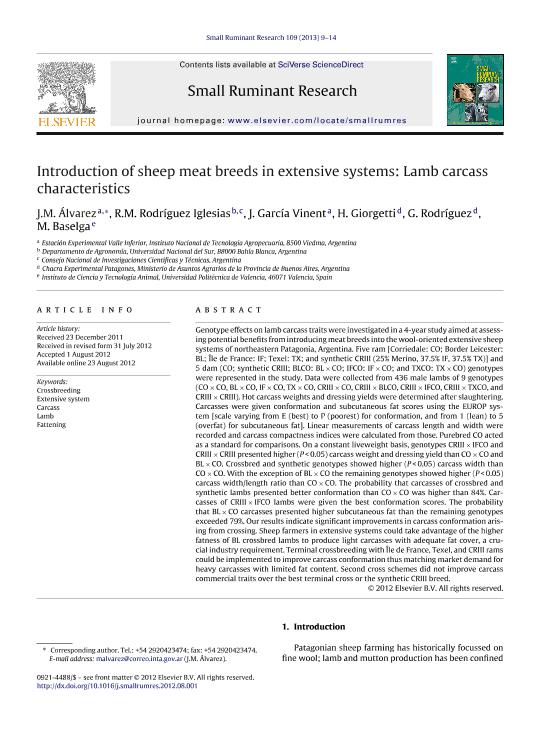Mostrar el registro sencillo del ítem
dc.contributor.author
Álvarez, J. M.
dc.contributor.author
Rodriguez Iglesias, Ricardo Manuel

dc.contributor.author
García Vinent, J.
dc.contributor.author
Giorgetti, H.
dc.contributor.author
Rodriguez, Gisela Mariel

dc.contributor.author
Baselga, M.
dc.date.available
2017-02-02T21:10:01Z
dc.date.issued
2013-01
dc.identifier.citation
Álvarez, J. M.; Rodriguez Iglesias, Ricardo Manuel; García Vinent, J.; Giorgetti, H.; Rodriguez, Gisela Mariel; et al.; Introduction of Sheep Meat Breeds in Extensive Systems: Lamb Carcass Characteristics; Elsevier Science; Journal Of Small Ruminant Research; 109; 1; 1-2013; 9-14
dc.identifier.issn
0921-4488
dc.identifier.uri
http://hdl.handle.net/11336/12402
dc.description.abstract
Genotype effects on lamb carcass traits were investigated in a 4-year study aimed at assessing potential benefits from introducing meat breeds into the wool-oriented extensive sheep systems of northeastern Patagonia, Argentina. Five ram [Corriedale: CO; Border Leicester: BL; Île de France: IF; Texel: TX; and synthetic CRIII (25% Merino, 37.5% IF, 37.5% TX)] and 5 dam (CO; synthetic CRIII; BLCO: BL × CO; IFCO: IF × CO; and TXCO: TX × CO) genotypes were represented in the study. Data were collected from 436 male lambs of 9 genotypes (CO × CO, BL × CO, IF × CO, TX × CO, CRIII × CO, CRIII × BLCO, CRIII × IFCO, CRIII × TXCO, and CRIII × CRIII). Hot carcass weights and dressing yields were determined after slaughtering. Carcasses were given conformation and subcutaneous fat scores using the EUROP system [scale varying from E (best) to P (poorest) for conformation, and from 1 (lean) to 5 (overfat) for subcutaneous fat]. Linear measurements of carcass length and width were recorded and carcass compactness indices were calculated from those. Purebred CO acted as a standard for comparisons. On a constant liveweight basis, genotypes CRIII × IFCO and CRIII × CRIII presented higher (P < 0.05) carcass weight and dressing yield than CO × CO and BL × CO. Crossbred and synthetic genotypes showed higher (P < 0.05) carcass width than CO × CO. With the exception of BL × CO the remaining genotypes showed higher (P < 0.05) carcass width/length ratio than CO × CO. The probability that carcasses of crossbred and synthetic lambs presented better conformation than CO × CO was higher than 84%. Carcasses of CRIII × IFCO lambs were given the best conformation scores. The probability that BL × CO carcasses presented higher subcutaneous fat than the remaining genotypes exceeded 79%. Our results indicate significant improvements in carcass conformation arising from crossing. Sheep farmers in extensive systems could take advantage of the higher fatness of BL crossbred lambs to produce light carcasses with adequate fat cover, a crucial industry requirement. Terminal crossbreeding with Île de France, Texel, and CRIII rams could be implemented to improve carcass conformation thus matching market demand for heavy carcasses with limited fat content. Second cross schemes did not improve carcass commercial traits over the best terminal cross or the synthetic CRIII breed.
dc.format
application/pdf
dc.language.iso
eng
dc.publisher
Elsevier Science

dc.rights
info:eu-repo/semantics/openAccess
dc.rights.uri
https://creativecommons.org/licenses/by-nc-nd/2.5/ar/
dc.subject
Crossbreeding
dc.subject
Extensive System
dc.subject
Carcass
dc.subject
Lamb
dc.subject
Fattening
dc.subject.classification
Genética y Herencia

dc.subject.classification
Ciencias Biológicas

dc.subject.classification
CIENCIAS NATURALES Y EXACTAS

dc.subject.classification
Otras Producción Animal y Lechería

dc.subject.classification
Producción Animal y Lechería

dc.subject.classification
CIENCIAS AGRÍCOLAS

dc.title
Introduction of Sheep Meat Breeds in Extensive Systems: Lamb Carcass Characteristics
dc.type
info:eu-repo/semantics/article
dc.type
info:ar-repo/semantics/artículo
dc.type
info:eu-repo/semantics/publishedVersion
dc.date.updated
2017-02-02T14:06:46Z
dc.journal.volume
109
dc.journal.number
1
dc.journal.pagination
9-14
dc.journal.pais
Países Bajos

dc.journal.ciudad
Ámsterdam
dc.description.fil
Fil: Álvarez, J. M.. Instituto Nacional de Tecnología Agropecuaria. Centro Regional Patagonia Norte; Argentina
dc.description.fil
Fil: Rodriguez Iglesias, Ricardo Manuel. Universidad Nacional del Sur. Departamento de Agronomía; Argentina. Consejo Nacional de Investigaciones Científicas y Técnicas; Argentina
dc.description.fil
Fil: García Vinent, J.. Instituto Nacional de Tecnología Agropecuaria. Centro Regional Patagonia Norte; Argentina
dc.description.fil
Fil: Giorgetti, H.. Provincia de Buenos Aires. Ministerio de Asuntos Agrarios. Chacra Experimental de Patagones; Argentina
dc.description.fil
Fil: Rodriguez, Gisela Mariel. Provincia de Buenos Aires. Ministerio de Asuntos Agrarios; Argentina. Consejo Nacional de Investigaciones Científicas y Técnicas; Argentina
dc.description.fil
Fil: Baselga, M.. Universidad Politecnica de Valencia; España
dc.journal.title
Journal Of Small Ruminant Research

dc.relation.alternativeid
info:eu-repo/semantics/altIdentifier/url/http://www.sciencedirect.com/science/article/pii/S0921448812003495
dc.relation.alternativeid
info:eu-repo/semantics/altIdentifier/doi/http://dx.doi.org/10.1016/j.smallrumres.2012.08.001
Archivos asociados
